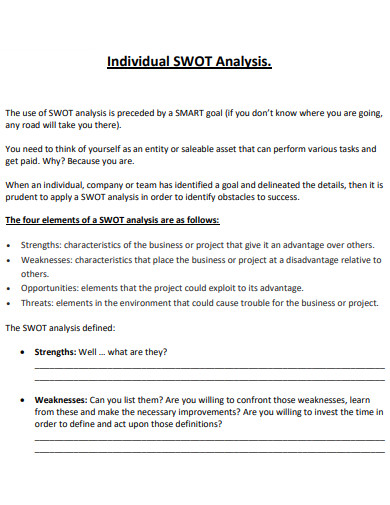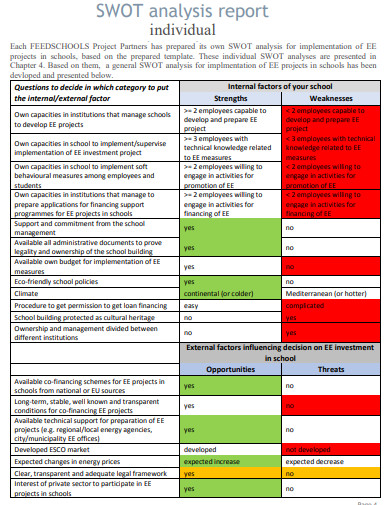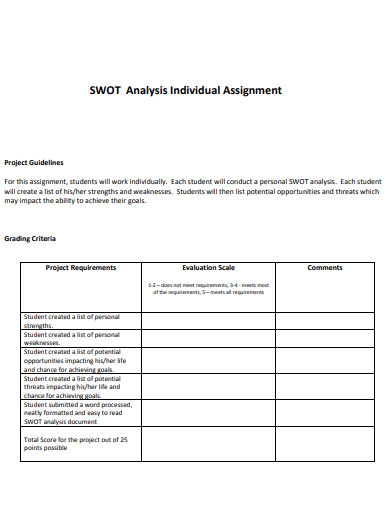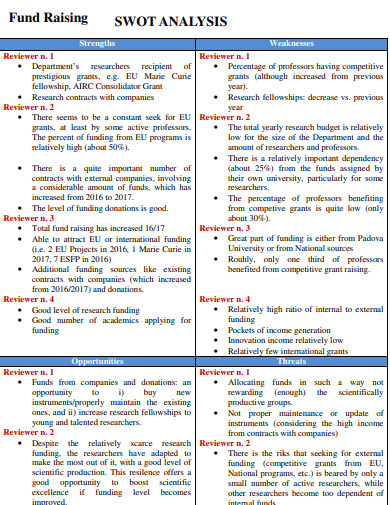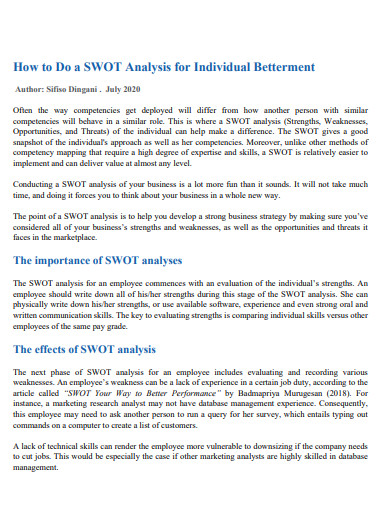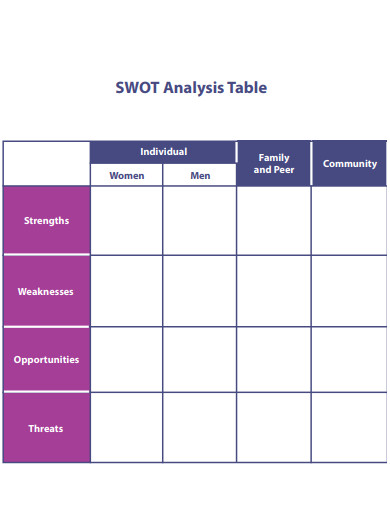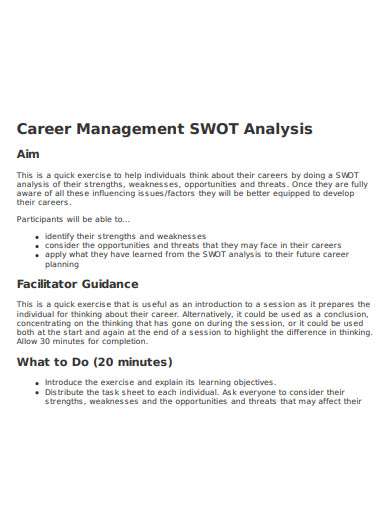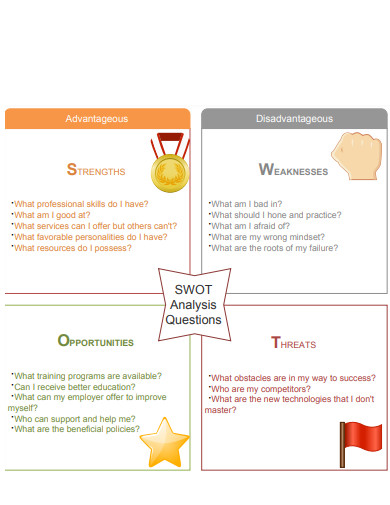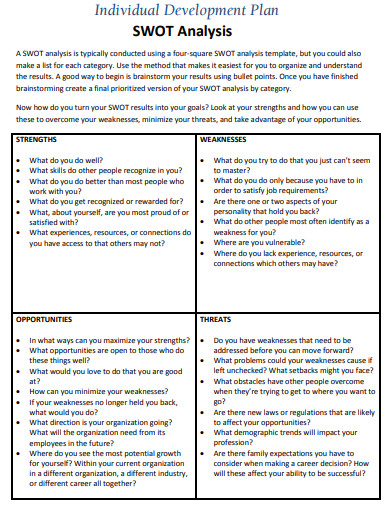When conducting a SWOT analysis, an individual should first identify their strengths, which are positive attributes or abilities that they possess that can help them to achieve their personal goals. These could include things like a strong work ethic, a high level of expertise in a particular field, or a good network of contacts. Next, an individual should identify their weaknesses, which are negative attributes or areas where they need improvement. These could include things like a lack of employee experience in a particular field, poor time management skills, or a tendency to procrastinate.
10+ Individual Swot Analysis Samples
1. Individual Swot Analysis
2. Individual Swot Analysis Report
3. Individual Swot Analysis Assignment
4. Individual Fund Raising Swot Analysis
5. Individual Betterment Swot Analysis
6. Individual Swot Analysis Table
7. Individual Career Management Swot Analysis
8. General Individual Swot Analysis
9. Basic Individual Swot Analysis
10. Simple Individual Swot Analysis
11. Individual Swot Analysis Development Plan
What Is Individual SWOT Analysis?
A SWOT analysis is a tool used to evaluate the strengths, weaknesses, opportunities, and threats of a particular individual, company business, or organization. A SWOT analysis can help an individual employee to identify their personal and professional strengths and weaknesses, as well as external factors that may impact their career plan or personal goals.
How To Make an Individual SWOT Analysis?
An individual SWOT analysis is similar to the SWOT analysis that is often used for lean business or organizational planning, but instead is focused on an individual’s personal and professional development. The process of conducting an individual SWOT analysis typically involves the following steps:
Step 1- Identifying SWOT
Identifying an individual’s strengths, which are positive attributes or abilities that they possess that can help them to achieve their goals. Identifying an individual’s weaknesses, which are negative attributes or areas where they need improvement. Be honest with yourself when identifying weaknesses, and remember that everyone has them.
Step 2- External Opportunities
Identifying external opportunities that could be beneficial to the individual’s career or personal goals, such as new job offer openings, training programs, or mentorship opportunities. Opportunities could also include changes in the job market or advancements in technology that align with your skill set.
Step 3- External Threats
Identifying external threats that could negatively impact the individual’s career or personal goals, such as economic downturns, increased competition, or changes in technology or industry standards. Also consider personal or professional challenges that could limit your progress
Step 4- Evaluate Findings
Evaluate the findings of the analysis to create action plans on how to leverage their strengths and opportnities, addressing their weaknesses and mitigating or exploiting the threats. Based on your evaluation, create a list of actionable steps you can take to achieve your goal, and prioritize them. Set milestones and deadlines for yourself, and revisit your SWOT analysis regularly to track your progress and make adjustments as needed.
What is the purpose of an individual SWOT analysis?
An individual SWOT analysis is a tool used by individuals to evaluate their personal strengths, weaknesses, opportunities, and threats in relation to achieving their personal or professional goals. It helps identify areas for improvement and set goals for personal and professional growth.
What are some examples of strengths in an individual SWOT analysis?
Examples of strengths in an individual SWOT analysis may include a strong work ethic, a high level of expertise in a particular field, excellent communication skills, or a good network of contacts.
What are some examples of weaknesses in an individual SWOT analysis?
Examples of weaknesses in an individual SWOT analysis may include lack of experience in a particular field, poor time management skills, lack of organization, or a tendency to procrastinate.
Overall, an individual SWOT analysis can be a useful tool for personal and professional development, as it can help individuals to identify areas for improvement and to set goals for personal and professional growth.
Related Posts
FREE 10+ Analysis of Alternatives Samples in PDF
FREE 10+ Failure Mode and Effects Analysis Samples in PDF
FREE 10+ Make or Buy Analysis Samples in PDF
FREE 10+ Fishbone Root Cause Analysis Samples in PDF
FREE 11+ Cost Volume Profit Analysis Samples & Templates in PDF | MS Word
FREE 6+ Corporate Portfolio Analysis Samples in PDF
FREE 10+ Fault Tree Analysis Samples in PDF
FREE 10+ Comp Analysis Samples in PDF
FREE 10+ Fishbone Analysis Samples in PDF
FREE 10+ 5 Year Analysis Samples in PDF
FREE 10+ Benefit Costs Analysis Samples in PDF
FREE 10+ Job Hazard Analysis Samples in PDF
FREE 10+ Primary Source Analysis Samples in PDF
FREE 10+ Critical Path Analysis Samples in PDF
FREE 10+ Competition Analysis Samples in PDF

